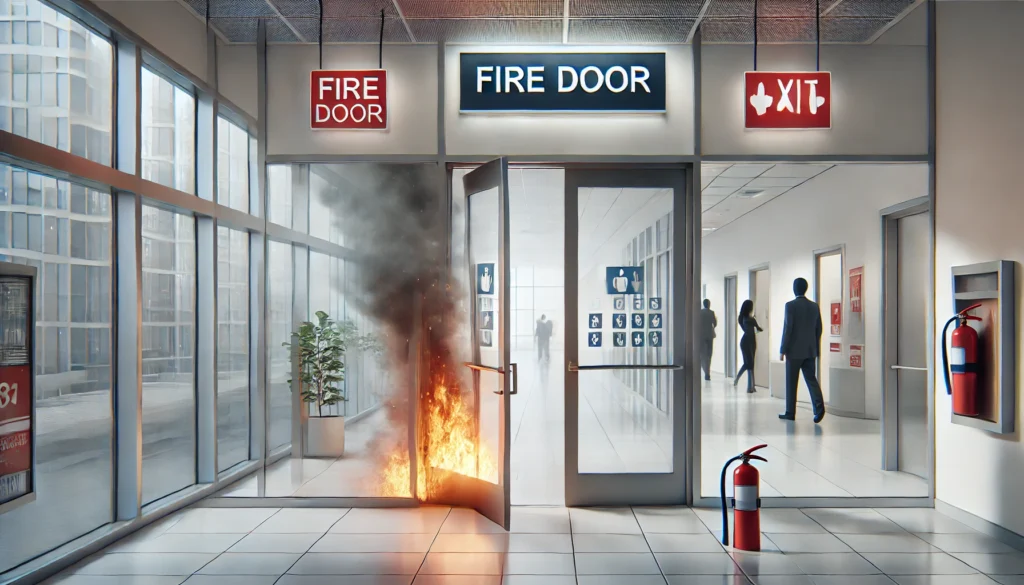Fire safety is a critical aspect of any building, whether residential, commercial, or industrial. Among the various safety measures, fire doors play a pivotal role in protecting lives and property. In this comprehensive guide, we will delve into the significance of fire doors, their installation, maintenance, and much more.

What Are Fire Doors?
Fire doors are specially designed doors that can withstand fire and smoke for a certain period, providing crucial time for occupants to evacuate and firefighters to control the blaze. They are an integral part of a building’s passive fire protection system.
Types of Fire Doors:
- Timber Fire Doors: Common in residential buildings.
- Steel Fire Doors: Often used in commercial and industrial settings.
- Glass Fire Doors: Provide fire protection while allowing visibility.
- Composite Fire Doors: Made from a combination of materials for enhanced performance.
Components of a Fire Door:
- Door Leaf: The main part of the door.
- Frame: Surrounds the door leaf.
- Seals: Intumescent seals expand in heat to seal gaps.
- Hardware: Includes hinges, handles, and self-closing devices.
Importance of Fire Doors
Fire doors are essential for containing fire and smoke, preventing their spread to other parts of the building. They create safe escape routes, providing vital time for evacuation. Real-life incidents and statistics have shown that properly installed and maintained fire doors can significantly reduce fire-related casualties and damage.
Legal Requirements and Standards
Different regions have specific building codes and regulations for fire doors. Key standards to consider include:
- BS 476: British Standard for fire resistance.
- EN 1634: European standard for fire resistance.
- NFPA 80: National Fire Protection Association standard in the USA.
Compliance with these standards is crucial. Regular inspections ensure that fire doors meet the necessary safety criteria.
Choosing the Right Fire Door
Selecting the appropriate fire door involves several considerations:
- Fire Rating: Indicates how long the door can withstand fire (e.g., 30, 60, 90 minutes).
- Material: Depends on the building’s requirements.
- Design: Must complement the building’s aesthetics while ensuring safety.
Always opt for certified and tested fire doors to guarantee reliability.
Installation Best Practices
Proper installation is vital for the effectiveness of fire doors. Follow these steps for a successful installation:
- Prepare the Opening: Ensure the door frame fits perfectly.
- Install the Frame: Secure the frame using appropriate fixings.
- Fit the Door Leaf: Attach the door leaf to the frame with certified hinges.
- Add Seals and Hardware: Install intumescent seals and self-closing devices.
Avoid common mistakes such as improper fitting and incorrect seal placement by hiring professional installers.

Maintenance and Inspections
Regular maintenance and inspections are essential to ensure fire doors function correctly. Here’s a checklist for routine maintenance:
- Check Seals: Ensure intumescent seals are intact.
- Inspect Hinges and Closers: Verify that hinges and self-closing devices are working properly.
- Test the Door Leaf: Ensure the door closes fully and latches automatically.
Signs that a fire door needs repair or replacement include damaged seals, warped door leaf, and malfunctioning hardware.
Upgrading and Retrofitting
Older fire doors may not meet current standards. Upgrading or retrofitting can enhance their performance. Consider the following options:
- Replace Seals and Hardware: Upgrade to modern, certified components.
- Rehang the Door: Ensure the door fits perfectly in the frame.
- Install New Fire Doors: Replace outdated doors with certified ones.
Retrofitting fire doors in existing buildings significantly improves fire safety without extensive renovations.
Fire Door Myths and Misconceptions
There are several myths about fire doors that can lead to dangerous practices. Let’s debunk some common misconceptions:
- Myth: Any door can act as a fire door. Fact: Only certified fire doors are designed to withstand fire and smoke.
- Myth: Fire doors should always be kept open for convenience. Fact: Fire doors must remain closed or be fitted with automatic closing devices to be effective.
- Myth: Fire doors do not need regular maintenance. Fact: Regular inspections and maintenance are crucial for their effectiveness.
Case Studies and Success Stories
Real-world examples demonstrate the life-saving potential of fire doors. For instance, in a recent commercial building fire, the presence of certified fire doors prevented the spread of smoke and flames, allowing all occupants to evacuate safely. Testimonials from businesses and homeowners further emphasize the importance of investing in quality fire doors.
Conclusion
Fire doors are an indispensable part of a building’s fire safety strategy. Ensuring they are properly installed, maintained, and compliant with regulations can make a significant difference in an emergency. Regular inspections and upgrades are essential to keep them functioning optimally.
For more information and professional fire door services, subscribe to our blog and stay updated with the latest safety tips and regulations. If you need assistance with fire door inspection or installation, contact us for a free consultation.

